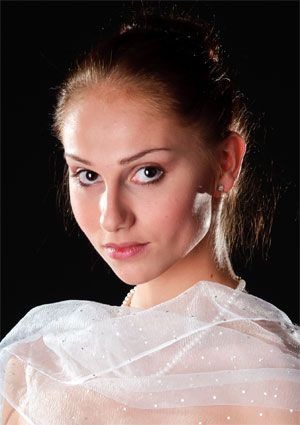
She has long deserved the title of genius. Her mastery has been honed to the degree that it is not just powerful, but meaningful too. She also possesses that which may be seen in Balanchine’s productions of Petipa: refinement in ballet is a ‘dancer-proof’ thing, the plastique is emotional in itself. Her character suits Aurora. Or Zoya in Yakobson’s The Bedbug. Osmolkina has the rare gift for acting where her positive heroines are not exactly more vivid but definitely no less interesting than her tragic or negative roles. Her Shyrin is the best today and, it would appear, not just at the Mariinsky Theatre. In The Legend of Love Osmolkina has a dazzling duet with Ulyana Lopatkina: here there are no questions as to why Ferkhad has fallen in love with Shyrin and why Mekhmeneh Bahnu is the Queen.
Kultura
Yekaterina Osmolkina was an absolutely magnificent Flore: her heroine saw herself as an adornment and was proud of the fact. A brilliant and carefree technique, as well as a brilliant sense of style.
Vremya Novostei
Osmolkina appears to equally brilliant acclaim in the most diverse roles, and the grotesque of her Die Puppenfee may be compared with her stunning lyricism in Giselle. Yekaterina performed the pas de deux in Act II of this ballet with this year’s Spirit of Dance winner Vladimir Shklyarov in such style that the balletomanes had tears in their eyes.
Literaturnaya Gazeta
Born in Leningrad (St Petersburg).
Graduated from the Vaganova Academy of Russian Ballet in 1997 (class of Marina Vasilieva). Joined the Mariinsky Ballet in 1997.
She has toured with the Mariinsky Ballet to Great Britain, Germany, Finland, Greece, China, Hong Kong and Azerbaijan.
Repertoire includes:
La Sylphide (the Sylph); choreography by August Bournonville, revised version by Elsa Marianne von Rosen,
Giselle (Monna, Zulma, Pas de deux from Act I); choreography by Jean Coralli, Jules Perrot, Marius Petipa,
Le Corsaire (Trio of Odalisques); production by Pyotr Gusev after the composition and choreography by Marius Petipa,
La Bayadère (D’Jampe, Grand pas, Trio of Shades); choreography by Marius Petipa, revised version by Vakhtang Chabukiani,
The Sleeping Beauty (Canary Fairy, Little Red Riding Hood, the White Cat); choreography by Marius Petipa, revival of the 1890 production,
The Sleeping Beauty (Carefree Fairy, Gold Fairy, Diamond Fairy, Courage Fairy, Sapphire Fairy); choreography by Marius Petipa, revised version by Konstantin Sergeyev,
Le Réveil de Flore (Aurora); choreography by Marius Petipa, revival of the 1894 production, Swan Lake (Pas de trois, Cygnets, Neapolitan Dance); choreography by Marius Petipa and Lev Ivanov, revised version by Konstantin Sergeyev,
Raymonda (Henrietta, variation in the Dream scene, Grand pas); choreography by Marius Petipa, revised version by Konstantin Sergeyev,
“Paquita” Grand pas; choreography by Marius Petipa,
Don Quixote (Amour, Flower-Sellers, Variation); choreography by Alexander Gorsky after motifs of Marius Petipa’s production,
Michel Fokine’s ballets Chopiniana (Nocturne, Eleventh Waltz, First Waltz), Carnaval (Columbine, Butterfly), Le Spectre de la rose (the Girl) and Pétrouchka (Ballerina, Dancers),
The Fountain of Bakhchisarai (Maria); choreography by Rostislav Zakharov,
Romeo and Juliet (Juliet’s Companion, Folk Dance); choreography by Leonid Lavrovsky,
The Nutcracker (Doll, Waltz of the Snowflakes); choreography by Vasily Vainonen,
The Young Lady and the Hooligan (the Young Lady); choreography by Konstantin Boyarsky,
Leonid Yakobson’s ballets Spartacus (Menada) and The Bedbug (Elzevira Renaissance),
The Legend of Love (Shyrin’s Friends, Gold Dance); choreography by Yuri Grigorovich,
Pas de quatre (Carlotta Grisi); choreography by Anton Dolin after motifs of Jules Perrot, George Balanchine’s ballets Apollo (Calliope, Polyhymnia), Symphony in C (I. Allegro vivo), Theme and Variations, The Four Temperaments (Melancholy), Jewels (Emeralds, Diamonds), Piano Concerto No 2 (Ballet Imperial), Scotch Symphony, La Valse and Serenade, A Midsummer Night’s Dream (Hermia),
Études; choreography by Harald Lander,
Now and Then; choreography by John Neumeier,
The Nutcracker (Canteen-Keeper, Bees’ Pas de trois); production by Mihail Chemiakin, choreography by Kirill Simonov,
Alexei Ratmansky’s ballets Le Baiser de la fée (Friends of the Bride),
The Little Humpbacked Horse (Wet-Nurses), Anna Karenina (Kitty) and Cinderella (Female Dance),
William Forsythe’s ballets In the Middle, Somewhat Elevated and Approximate Sonata,
Reverence; choreography by David Dawson,
Ondine (Two Naiads); choreography by Pierre Lacotte,
Glass Heart (the Gardener’s Wife); choreography by Kirill Simonov,
“The Overcoat” after Gogol (the Girl); choreography by Noah D. Gelber,
The Golden Age (Valkyries); choreography by Noah D. Gelber,
Diana Vishneva: Beauty in Motion (F.L.O.W.; choreography by Moses Pendleton, Three Point Turn; choreography by Dwight Rhoden),
and Without; choreography by Benjamin Millepied.
Repertoire also includes:
Romance; choreography by Dmitry Bryantsev,
the Pas d’action from the ballet Laurencia; choreography by Vakhtang Chabukiani and dances in the operas Sadko (Fish with Golden Feathers), Ruslan and Lyudmila (Dances of Naina’s Charms) and Faust (Nymphs).
